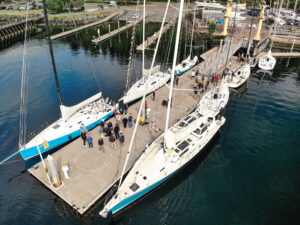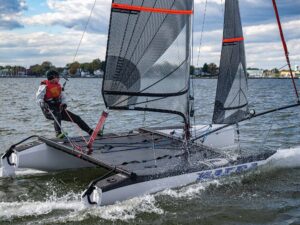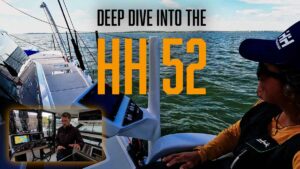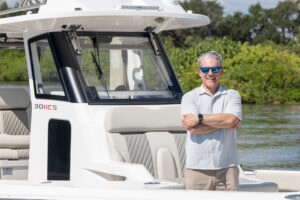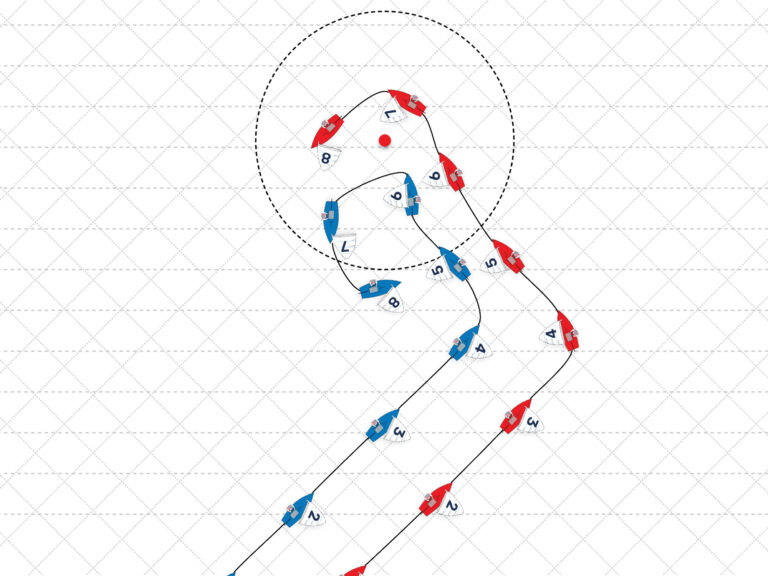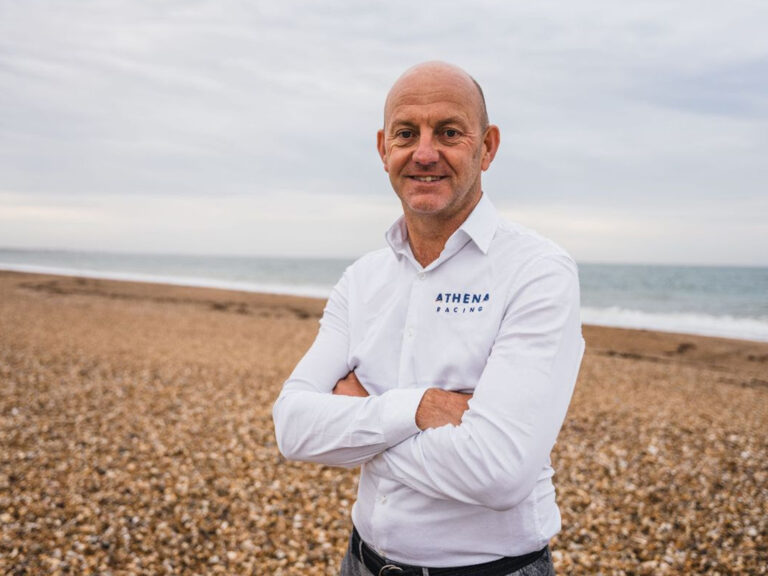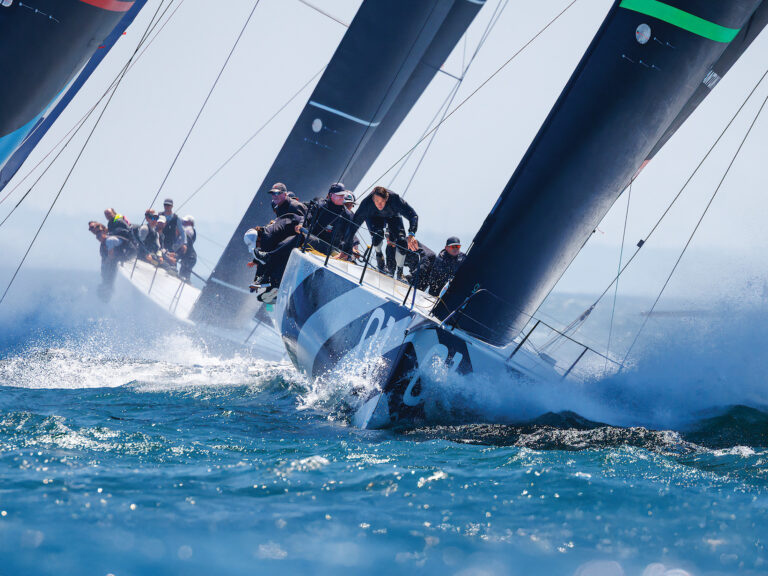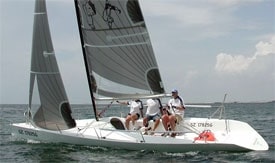
js 9000 review
My first encounter with the JS 9000 happened on terra firma. While staring up at its ridiculously narrow canoe body, its needle nose, its plumb bow, and thin appendages that seemed to stretch into eternity, I realized an adolescent dream had come true: I was standing in front of the ultimate “baaad-ass” boat. And this term is not to be taken lightly. It’s the highest decoration bestowed upon cool, unusual, mean, and fast-moving objects. The boat comes to U.S. shores from Down Under, and is designed by John Swarbrick, member of an established boat-building family in Western Australia. Swarbrick apprenticed under Alan Payne, worked on Chris Dickson’s Whitbread 60 Tokio, and for Team New Zealand’s recent AC campaign. Earlier this year, Swarbrick had an injunction upheld against Boldgold Investments, an unauthorized builder of the JS 9000. It isn’t easy to copyright a boat design, but the judge considered “the original handcrafted model of the yacht, and the yacht itself … works of artistic craftsmanship.” If nothing else, the incident is proof that imitation is the highest form of flattery. Given Swarbrick’s pedigree, it’s not exactly surprising the JS 9000 looks a bit like an ACC boat, drawing its performance from a light, narrow hull with deep appendages and a massive bulb at the business end of the keel. It’s a low-drag machine with little form stability and absolutely no intention-or necessity-to get on a plane. Two people in the huge cockpit may get lonely, but two pairs of hands is all this boat needs. The self-tending jib and a trim pod on the centerline in the forward half of the cockpit keep the throttles within the crew’s reach. There are no hiking straps or trapeze wires because what’s the point of hiking when the boat heels more than 30 degrees and the 1,500-pound keel bulb projects much farther to windward than any butt ever could? This gives the driver leisure to play with traveler and sheet to adjust the 200-square-foot square-top main. A look down below reveals basic home cooking and a lot of emptiness. It will take a bit of imagination and Houdini skills to find a place for the Porta-Potty and a pipe berth, but it isn’t impossible. The laminate is hand-laid fiberglass mat vacuum, infused with vinylester resin, over Herex core. Structural bulkheads are made from molded composite sandwich and the transverse chainplates are stainless-steel plates bolted to the hull-deck knee. The original high-aspect ratio rudder has been tweaked for better balance and more lift. It’s attached to a 32-mm shaft made of marine-grade stainless steel. The composite keel case has to deal with impressive loads generated by the lead bulb. Strut and ballast are encapsulated in fiberglass. On a boat that draws close to 7 feet like the JS 9000, a lifting keel should be standard, not just an option. Motor? What motor? This thing is so slippery, a sea bass could push it. But if you insist, either stern or side-mount motor brackets are available. Anything less than an optional carbon stick on this runnerless rig doesn’t make sense. Early shrimping experiments and breakage motivated sparmaker Composite Spars and Tubes to make modifications. The top of the tube remains flexible to allow the main to twist, but the bottom half now has more wall thickness. The boom is aluminum. The JS 9000 is so skinny that the asymmetric kites can be flown directly off the bow-no bowsprit required. After shoving off from the dock in Alameda, Calif., in a mild 10-knot breeze it became clear that a keelboater’s sense of speed and distance gets radically modified and you must be comfortable on an incline. Holding fast and bracing one’s feet is key for first-timers, even in a light to moderate breeze. Once the crew sorts through the colored control lines, trimming is easy over the center winch. Here, a two-speed model would be a huge improvement. A source of migraine were the small Spinlock rope clutches, which seemed to have a mind of their own, closing but not biting-a problem possibly due to either the hardware or line being improperly specced. The control pod is cramped, so whatever alternative there is, it must be narrow. The Spinlock clutches for the halyards were up to the job. The test boat, one of the first in the States, had a hodgepodge of hardware installed, which the importer promised to change. Even with the self-tending jib there’s plenty of stuff to play with, e.g. halyard tension, sheeting angle, or main downhaul, and the boat dutifully responds to the changes. The rudder is pleasantly light and commands the boat with precision-as long as there’s flow on the thin foils. In other words: don’t stall it. The loose-footed main needed a bit of tweaking, but could be coaxed into decent shape, even though it clearly was cut for a higher breeze range. Sailing to weather, the plumb bow digs up a fountain-a.k.a. the “reverse waterfall” because the water jumps straight up into the headsail. Otherwise, the boat sails dry, putting the crew high above the water and far back so that a dose of spray on the nose is rare. Off the breeze, the jib is furled before the kite emerges from the companionway. Even with the 300-square foot chicken chute it moved well, easily outrunning a nearby RC 27 trimaran. On all angles of sail the Windex points forward, a function of the apparent wind generated by the boat’s swift movement through the water. “In light air the boat is deadly, not at all sticky like comparable sportboats with a wide stern that need planing speeds,” says Larry Anderson, a former beach cat sailor, who found a new calling as a JS 9000 jockey. “I’m intrigued by the design, the performance, and the sailing characteristics.” He notes that exorbitant pointing angles are not necessary, “because her speed results in stellar VMG, anyway.” Anderson, although not a hard-core racer, cleaned up in his PHRF class ( www.jsyachtsusa.com

